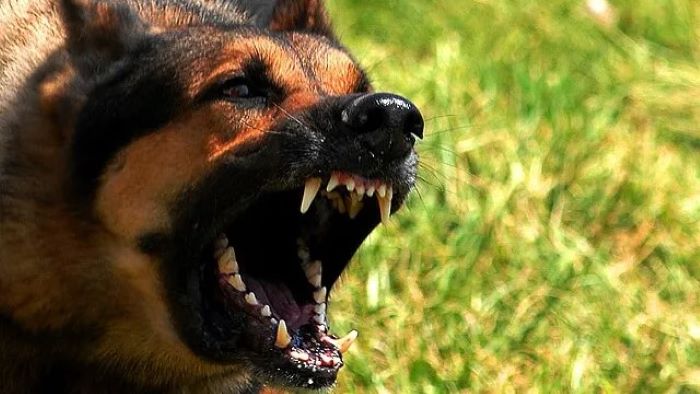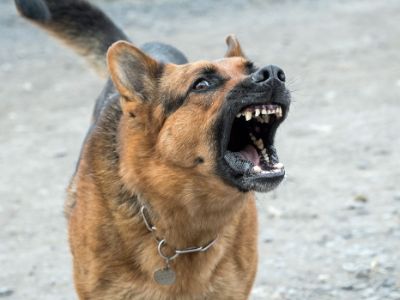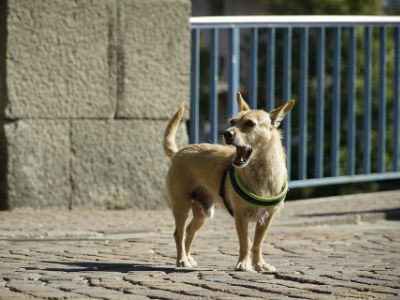Dogs are cute and adorable, but sometimes they can get aggressive and show violent behaviour. This can cause harm to people or animals, and lead to legal trouble for the owners. This article will show you how to report a dangerous dog in the UK, what the law says about dangerous dogs, and how to prevent and deal with dog attacks.

Key Takeaways
- A dangerous dog is one that is out of control and poses a threat to people or animals.
- You can report a dangerous dog to the local law enforcement or your council’s dog warden service.
- Owning or encountering a dangerous dog can have serious legal consequences, such as fines, prison sentences, or destruction of the dog.
- You can prevent your dog from becoming dangerous by identifying and avoiding triggers, bonding with your dog, training your dog, exercising your dog, socializing your dog, and seeking professional help if needed.
- You can defend yourself from an attacking dog by using an object, blocking their vision, protecting your head and neck, and not provoking them.
How To Report a Dangerous Dog?
When you encounter a dangerous dog, you can report it to the local law enforcement or your council’s dog warden service. But, what are the indications or signs to determine whether a dog is dangerous or not?
As per the UK government guidelines, a dog is deemed out of control if:
- It injures some individual
- Makes someone fearful that it might injure them
- Attacks someone’s pet
- The individual thinks they may get injured while stopping the dog
Let’s use this premise and get into the details of how you can determine whether a dog is dangerous or not.
Signs of a dangerous dog
To identify a dangerous dog you can look for the following behavioural traits:

- Growling
When a dog is growling it usually suggests a sign of aggression, regardless of the circumstances. So, if you see a dog growling, it generally means that the dog is either angry or scared. The dog may attack whoever is making him feel that way and if you somehow provoke them they might end up biting you.
- Barking
Continuous barking is also one of the signs of aggression. Although it’s not a definite prospect, dogs also bark to feel good and it gives them a pleasant experience. However, if they continue to bark, it can make them aggressive.
- Teeth clenching
At some point, you may have seen a dog clench their teeth before they get into a fight with another dog on the street. This behaviour is a definite prospect of a dog getting aggressive and posing threat to people or animals around them.
- Freezing
Freeing is an instance, where a dog gets close to a person and then freezes in that spot, and starts staring. This behaviour is also termed posturing or posing. While people often make the mistake of considering this a good sign, It’s usually not. You may think the dog likes you, but, in reality, it suggests that the dog is probably going to lunge out of that stance and bite the person who is in its pathway.
- Lunging
Lunging is an act where a dog jumps towards a person, animal or any other object. In such a situation, it becomes hard to anticipate a dog’s next move. For instance, they may directly bite an individual. During lunging, they also have the tendency to bark and growl.
- Direct eye contact
If a dog sees an individual staring at them or any sort of direct eye contact without any verbal communication, they will comprehend this behaviour as a challenge. They will attack instantly.
If you observe any of such signs you need to get in touch with the authorities. Further, there are certain breeds of dogs that are banned in the UK. These dogs tend to have aggressive behaviour and are illegal to own in the country. Pit Bull Terrier, Japanese Tosa, Dogo Argentino, and Fila Brasileiro are the dogs banned in UK.
Public Space Protection Orders
Formerly called Dog Control Orders (DOCs), Public Space Protection Orders i.e. PSPOs provide specific guidelines to control the behaviour of dogs in a social environment.
So, as a dog owner, whenever you are in a public space, you’ll have to follow these guidelines. Here are some of the important rules you need to follow:
- Keep your dog on a lead/harness
- Put on the lead if instructed by a police officer
There are other rules pertaining to the public place but these two are the ones you cannot miss, especially if your dog has a tendency to get aggressive. Ignoring the PSPO guideline can cost you a fine of about £100 (on the spot) and £1000 if the issue goes to court.
So, what happens if your dog is out of control and hurts someone?
The government guidelines are clear, and if your crime is proven, you may face severe penalties. These penalties are:
- Fine
If your dog has done something dangerous, and the incident is on record in court, the guilty verdict can see you get an unlimited fine or even prison.
- Prison
You will face a prison sentence if your dog has done something extremely violent. For instance, if your dog hurt an individual, you can get a prison sentence of up to 5 years, especially if you intentionally make them hurt someone.
Further, if the dog ends up killing someone, you will get a sentence of 14 years, an unlimited fine or face both penalties. Even if you allow your dog to injure other dogs, for example, a guide dog, you risk getting a hefty fine and prison sentence of up to 3 years.
So, it’s important to control your dog because in extreme cases, your dog can get destroyed as well.
Tips to control a dangerous dog
To avoid any dangerous situation in the public domain, here are some of the preventive measures you can consider while going out with your dog in public.
#1 Identify the trigger
The majority of dogs have a specific trigger which alters their behaviour. For example, if tyres scratch on the road, they get impulsive and get aggressive at that moment. Identifying such triggers can help you manage your dog if such a situation transpires while you are in a park or any other public place.
#2 Bond with your dog
Many dog owners, especially new ones make the mistake of not bonding with their dogs. In simple words, knowing their needs. This small mistake can lead to severe consequences as it can make dogs behave badly.
Further, the reason for this bad behaviour is nothing but, owners not providing enough attention. Dogs behave strangely or get aggressive to gain attention. So, it’s crucial for owners to connect with them emotionally.
#3 Train the dog for Interrupt commands
This method is your best shot at controlling your furry friend while you are in a public place. Train them while you give them a treat, use commands such as “stop”, “no”, don’t, “stay” or phrases like “leave it”. Once you make them follow these commands, try using them while they behave radically.
Follow this drill until they associate these commands with their bad behaviour. When you see them obey the commands, you can easily control their behaviour in public.
#4 Exercise
Exercise helps dogs burn some energy. So, if you plan on going out, you can leverage this aspect and make them exercise a bit at home. This will reduce their energy and when you are out in the public, they will remain calm and not get impulsive as they have already lost some energy while exercising.
#5 Diversion
Sometimes your dog can get aggressive for no reason, in such cases, you may panic. So, instead of panicking, you can look for ways to divert their attention. Keep some toys with you, they can come in handy in such situations.
#6 Socialisation
Socialising the dog can do wonders. They get used to different smells, their surroundings and people. This reduces the chances of them getting aggressive and acting dangerously in the public domain.
#7 Seek professional help
For beginners, it’s a safe bet to take help from a professional dog trainer or a behaviourist. They can easily identify behavioural traits and triggers to train the dog. In fact, experienced owners can also find it difficult to control the aggressive behaviour of dogs. Yes, it is costly, but, it’s better than going to prison or paying a high amount of fine for your dog’s dangerous behaviour.
Defending Yourself From a Dangerous Dog

At times, it’s possible that you are unaware of the nature of a particular dog and you suddenly get attacked. While you can surely register a legal complaint for such an incident you also need to defend yourself. So, how will you do that?
You can consider the following tips:
- Avoid direct eye contact
- Cross your arms
- Ignore the dog
- Shift your body to a different side
- Remain still and try to slowly move away
- Look for obstruction or a barrier to safeguard the dog
Now, you may think, what if this doesn’t work? In such cases, try doing this:
- Remain completely still
- Ask for help from the people around you, and make sure you don’t scream
- Don’t try using any command to communicate, chances are you may end up provoking them
Further, if the dog has already lunged at you, here are some ways you can protect yourself and ensure the dog doesn’t bite you:
- Use an object to redirect the dog bite, for instance, your bag, or any such item. You can also use a stick laying on the ground.
- Try not to scream, and look for a higher place to maintain distance from the dog
- Block the dog’s eyesight, use any relevant item such as your coat or shirt to block their vision. Doing this will buy you some time and you can easily escape.
- If you are in an isolated area, and dog attacks you, protect your head and neck. Wait for help if you are not making any progress in stopping the dog from biting you.
FAQs
Can I complain about the neighbour’s dog barking?
Sure you can! If the verbal gesture with your neighbour hasn’t worked out, you can definitely try contacting your local council about the noise complaint. You can also try contacting your local council about a barking dog and registering the complaint.
What does the Dangerous dog Act do?
Section one of the Dangerous Dogs Act (1991) outlaws 4 types of dogs; these dogs are- pitbull terrier, Japanese tosa, Dogo Argentino, and fila Brasileiro. The law makes it illegal to own, sell, breed, give away or dump any of these dogs.
Is Cane Corso banned in UK?
No, as of now, Cane Corso is not banned from the UK. However, it’s definitely against the law to let a dog be let out roaming dangerously out of control anywhere, in a public place. in a private place.
What happens if someone reports your dog for biting in the UK?
The UK law has different penalties that are applicable for such incidents. From a fine of up to £1,000 to a potential prison sentence, you can face some serious punishment for your dog’s biting or worst dangerous behaviour. Even if the incident is small, control orders include banning the dog from certain specific locations or types of places, and also requiring a lead or a muzzle while it’s roaming around in public
Is it OK to hit an attacking dog?
While it’s completely within your right to defend yourself, do not hit, kick or punch an attacking dog. Because you responding with aggression can escalate the situation and things can go sideways. Once the dog gets away and the attack on you settles down, immediately get yourself, your dog or your family member to safety. Don’t look back, try to get control of the situation, or try to locate the owner.
Wrapping Up
In conclusion, you can report a dangerous dog to the local council or the local police in the UK. Also, if you find owners neglecting the PSPO guidelines you can report such instances as well. In addition, if you’re a dog owner it’s your obligation to abide by all the legal guidelines to avoid any legal dispute.
Controlling your dog is challenging and we hope the tips in the article help you deal with your dog’s aggression. Also, if you are not a dog owner, prepare yourself to handle a situation where you may encounter an aggressive stray dog.



